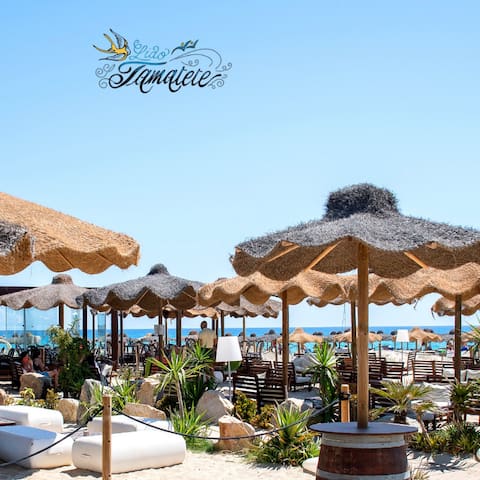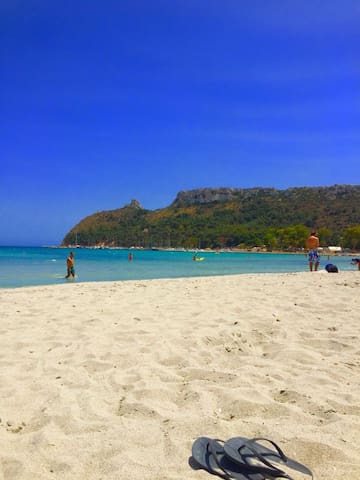Visite turistiche
The intense colours of the sea, the glimmering crystal-clear water, granite cliffs, enchanting coves, long stretches of beach, lagoons and verdant hills, some of them are the settings of TV ads and all of them are breathtaking. Villasimius is the ‘pearl’ of the south, the kind of tourist resort every vacationer dreams of, with a population of less than 4,000 during winter that blossoms to several tens of thousands in summer. The coastline is graced with a crown of beaches interspersed with inlets and the Capo Carbonara promontory. Along the panoramic road starting at Capo Boi, the southernmost point of the protected Marine Area, are the wonderful beaches of Porto sa Ruxi, Campus and Campulongu, all blessed with gorgeous blue seas and white sandy beaches framed by Mediterranean brush. Not far from town is the unusual spiaggia del Riso beach, remarkable for its rice-shaped sand. Past the modern-day tourist harbour, on the western side of Capo Carbonara, are inlets nestled between the cliffs, including Cala Caterina. On the eastern side are other breathtaking gems of the seashore, starting with Porto Giunco, and behind it the stagno di Notteri marshes where pink flamingos and other rare species of wild birds nest. From high up on the promontory that looks out over it, home to an Aragonese tower built by Spaniards, is an amazing panorama with will linger in your mind, your heart and your pictures for ever: an endless field of shades of blue, two seas divided by a narrow strip of white sand that looks like powdered sugar. Further north are the beaches of Simius and Traias, followed by Rio Trottu and Manunzas, that provide the backdrop for Punta Molentis, another ‘gem’ of Villasimius. From Capo Boi to the Island of Serpentara, the isola dei Cavoli and shoals that are the resting places of shipwrecks from all eras, the Capo Carbonara marine reserve is rich in underwater treasures: dense schools of fish move like weightless clouds over meadows of gently waving sea grass, over bastions, into valleys and channels coloured yellow by sea daisies and red by sea fans.
Back on land you can go shopping, enjoy delicious seafood, visit museums and pick over archaeological sites. Go see remains dating to the Nuragic age, tour the Accu Is Traias (I century BCE – III century CE) and Cruccuris (I-II CE) necropoles near the roman baths of Santa Maria, and the Cuccureddus site, an early Phoenician-Punic settlement later taken over by the Romans. And don’t miss the archaeological museum, with displays about the treasures that lie at the bottom of the sea. One of these, the statue of the Virgin of the Sea, lies on the bottom near Cavoli island. It was sculpted by Pinuccio Sciola and every year in late July they have the Festa della Madonna del Naufrago to commemorate those who lost their lives at sea with a procession that leads to the water’s edge.
20 當地人推薦
VILLASIMIUS - Sardegna Vacanze, la guida
The intense colours of the sea, the glimmering crystal-clear water, granite cliffs, enchanting coves, long stretches of beach, lagoons and verdant hills, some of them are the settings of TV ads and all of them are breathtaking. Villasimius is the ‘pearl’ of the south, the kind of tourist resort every vacationer dreams of, with a population of less than 4,000 during winter that blossoms to several tens of thousands in summer. The coastline is graced with a crown of beaches interspersed with inlets and the Capo Carbonara promontory. Along the panoramic road starting at Capo Boi, the southernmost point of the protected Marine Area, are the wonderful beaches of Porto sa Ruxi, Campus and Campulongu, all blessed with gorgeous blue seas and white sandy beaches framed by Mediterranean brush. Not far from town is the unusual spiaggia del Riso beach, remarkable for its rice-shaped sand. Past the modern-day tourist harbour, on the western side of Capo Carbonara, are inlets nestled between the cliffs, including Cala Caterina. On the eastern side are other breathtaking gems of the seashore, starting with Porto Giunco, and behind it the stagno di Notteri marshes where pink flamingos and other rare species of wild birds nest. From high up on the promontory that looks out over it, home to an Aragonese tower built by Spaniards, is an amazing panorama with will linger in your mind, your heart and your pictures for ever: an endless field of shades of blue, two seas divided by a narrow strip of white sand that looks like powdered sugar. Further north are the beaches of Simius and Traias, followed by Rio Trottu and Manunzas, that provide the backdrop for Punta Molentis, another ‘gem’ of Villasimius. From Capo Boi to the Island of Serpentara, the isola dei Cavoli and shoals that are the resting places of shipwrecks from all eras, the Capo Carbonara marine reserve is rich in underwater treasures: dense schools of fish move like weightless clouds over meadows of gently waving sea grass, over bastions, into valleys and channels coloured yellow by sea daisies and red by sea fans.
Back on land you can go shopping, enjoy delicious seafood, visit museums and pick over archaeological sites. Go see remains dating to the Nuragic age, tour the Accu Is Traias (I century BCE – III century CE) and Cruccuris (I-II CE) necropoles near the roman baths of Santa Maria, and the Cuccureddus site, an early Phoenician-Punic settlement later taken over by the Romans. And don’t miss the archaeological museum, with displays about the treasures that lie at the bottom of the sea. One of these, the statue of the Virgin of the Sea, lies on the bottom near Cavoli island. It was sculpted by Pinuccio Sciola and every year in late July they have the Festa della Madonna del Naufrago to commemorate those who lost their lives at sea with a procession that leads to the water’s edge.
The deep blue water, the green shrubs and delicate golden colour of the fine sand will make you fall in love with this natural marvel. In a cove between Capo Malfatano and Capo Spartivento, in the territory of Teulada, on the outermost point of the southwestern part of the Island, Tuerredda stretches for over half a kilometre and is quite simply a jewel with scenery resembling that of the Caribbean.
It appears from above with its little island facing it, easy to reach by swimming, in a background often framed by sailing boats at anchor but that look like they are resting on the crystal clear water. The little island, just a few hundred metres from the shore, is a little world all on its own, in which you can spend a few hours lying on the stand or on the hot, smooth rocks.
Thanks to its shape, the beach is well sheltered from the Mistral, north-westerly wind and its sea is almost always calm and clear, perfect for long swims with a mask and flippers or for doing some snorkelling. The nearby coastline is a mixture of gentle and rugged stretches and there is a series of little beaches, separated by rocky belts. Enjoy the countless top-quality services offered by the beach establishments, canoe and pedalo rentals, trips in rubber dinghies, nearby bars and restaurants.
By boat or by car, along the panoramic road (provincial road 71), don't miss your chance to roam around the beautiful places along the coast: Teulada and Chia (Domus de Maria) offer numerous other breathtaking beaches like Is Arenas in Porto Pino, Porto Tramatzu, Capo Malfatano, Cala Zafferano, Sa Colonia, Su Giudeu and others. Common denominators: sand dunes and crystal clear sea.
150 當地人推薦
圖爾雷達海灘
Località TuerreddaThe deep blue water, the green shrubs and delicate golden colour of the fine sand will make you fall in love with this natural marvel. In a cove between Capo Malfatano and Capo Spartivento, in the territory of Teulada, on the outermost point of the southwestern part of the Island, Tuerredda stretches for over half a kilometre and is quite simply a jewel with scenery resembling that of the Caribbean.
It appears from above with its little island facing it, easy to reach by swimming, in a background often framed by sailing boats at anchor but that look like they are resting on the crystal clear water. The little island, just a few hundred metres from the shore, is a little world all on its own, in which you can spend a few hours lying on the stand or on the hot, smooth rocks.
Thanks to its shape, the beach is well sheltered from the Mistral, north-westerly wind and its sea is almost always calm and clear, perfect for long swims with a mask and flippers or for doing some snorkelling. The nearby coastline is a mixture of gentle and rugged stretches and there is a series of little beaches, separated by rocky belts. Enjoy the countless top-quality services offered by the beach establishments, canoe and pedalo rentals, trips in rubber dinghies, nearby bars and restaurants.
By boat or by car, along the panoramic road (provincial road 71), don't miss your chance to roam around the beautiful places along the coast: Teulada and Chia (Domus de Maria) offer numerous other breathtaking beaches like Is Arenas in Porto Pino, Porto Tramatzu, Capo Malfatano, Cala Zafferano, Sa Colonia, Su Giudeu and others. Common denominators: sand dunes and crystal clear sea.
A vast and stunning city beach, with eight kilometres of coastline extending between Cagliari and Quartu Sant'Elena comprised of soft sand, blue sea, relaxation, fun and sport.
330 當地人推薦
Poetto
2 Piazza degli ArcipelaghiA vast and stunning city beach, with eight kilometres of coastline extending between Cagliari and Quartu Sant'Elena comprised of soft sand, blue sea, relaxation, fun and sport.



